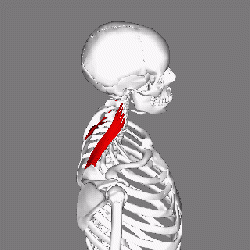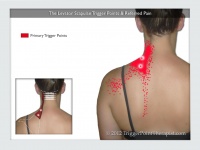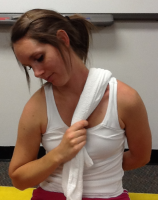Levator Scapulae Syndrome: Difference between revisions
No edit summary |
No edit summary |
||
| (32 intermediate revisions by 11 users not shown) | |||
| Line 1: | Line 1: | ||
<div class="editorbox"> | <div class="editorbox"> '''Original Editor ''' [[User:Andeela Hafeez|Andeela Hafeez]] | ||
'''Top Contributors''' - {{Special:Contributors/{{FULLPAGENAME}}}} | |||
</div> | |||
== Introduction == | |||
= | [[Levator_Scapulae_Syndrome|Levator Scapulae Syndrome]] is a historical name for "pain over the upper medial angle of the scapula"<ref name="Menachem">Menachem A1, Kaplan O, Dekel S. Levator scapulae syndrome: an anatomic-clinical study. Bull Hosp Jt Dis. 1993 Spring;53(1):21-4. Level of Evidence 3B</ref> that is still used in clinical practice in certain settings round the world. This terminology (and use of the word syndrome) describes a set of signs and symptoms that often present together without identifying the cause of the pain and dysfunction, as is the case with other syndromes such as chronic fatigue syndrome and irritable bowel syndrome. It is widely considered a better practice to use more specific terminology that refers to relevant causative factors that can be addressed during treatment. | ||
== Clinically Relevant Anatomy == | |||
[[Image:Levator scapulae muscle animation small2.gif|right|250x250px]] | |||
The [[Levator Scapulae|levator scapulae]] muscle extends from C1-4 to the medial aspect of the scapula, between the superior angle and the root of the scapular spine. Its function is to assist with various neck, arm and shoulder movements such as shoulder elevation and cervical side flexion. | |||
== Description == | |||
This muscle often becomes tense and painful leading to reduced motion in the area. Evidence indicates an association between mechanical neck pain (MNP) and dysfunction of the muscles of the cervical spine<ref>Shaun O'Leary, Deborah Falla, James M. Elliott, Gwendolen Jull. Muscle Dysfunction in Cervical Spine Pain: Implications for Assessment and Management. Journal of Orthopaedic & Sports Physical Therapy, 2009 39(5):324–333 Level of Evidence 5</ref>. The dominant shoulder is most commonly involved (82%) and pain radiates to the neck and shoulder, but rarely to the arm<ref name="Menachem" />. | |||
== Causes == | |||
*Cervical spine dysfunction. | |||
*Altered shoulder biomechanics or poor posture. | |||
*Repetitive arm motions such as in swimming, throwing, or racquet sports. | |||
*Carrying bags with straps over the shoulder. | |||
*Stress/anxiety. Many individuals who experience the effects of these trigger points also complain of shortness of breath (similar to that associated with panic attacks). | |||
== Sign and Symptoms == | |||
Pain | *Neck pain, which may extend to the head causing a headache. | ||
*Pain and restricted range of movement especially reduced cervical flexion and side flexion to the contralateral side. | |||
*Deep, achy pain and/or tightness on the upper back along the top of the shoulder blade or neck. | |||
*Increased muscle tone and trigger points. Active trigger points are more frequent in patients presenting with mechanical neck pain<ref>C. Fernández-de-las-Peñas, C. Alonso-Blanco, J.C. Miangolarra. Myofascial trigger points in subjects presenting with mechanical neck pain: A blinded, controlled study. Manual Therapy, 2007, 12(1):29–33 Level of Evidence 1B</ref> | |||
[[Image:Levator scapula trigger points referred pain.jpg|right|200px]] | |||
=== Trigger points === | === Trigger points === | ||
The Levator Scapulae can | The Levator Scapulae can present with two trigger points located in the lower half of the muscle. The lower trigger point lies just above the superior angle of the scapula and the upper trigger point lies 1-3 inches above the lower trigger point. Both trigger points lie deep to the upper trapezius muscle and both refer pain laterally to the shoulder and along the medial aspect of the shoulder blade. | ||
Trigger points in the Levator Scapulae are also commonly misdiagnosed as cervical joint dysfunction so careful cervical assessment is required for individuals that present with these symptoms<ref>Bosch L. ''The effectiveness of chiropractic adjustments with ischemic compression or ultrasound on active levator scapulae trigger points in physically active people'' (Doctoral dissertation, University of Johannesburg).</ref>. | |||
= | == Examination == | ||
With this presentation of pain and trigger points in the region of the levator scapulae, it is important to complete a full [[Cervical Examination|assessment of the '''cervical spine''']] as pain in this region is often referred from the cervical spine. | |||
The presenting pain is likely to be reproduced on '''active and passive range of movement''' testing of the cervical spine especially flexion and side flexion to the contralateral side (placing the muscle in a lengthened position). The muscle is also likely to be tender on palpation and may present with increased tone, especially in the region and referral pattern of the trigger points. | |||
You must also rule out the thoracic spine and shoulder. The phenomenon of levator scapulae pain of cervical origin being reproduced on shoulder movement has long been clinically recognized<ref name="Behrsin">Behrsin JF and Maguire K. Levator Scapulae Action during Shoulder Movement: A Possible Mechanism for Shoulder Pain of Cervical Origin. Australian Journal of Physiotherapy, 1986, 32(2):101–106 Level of Evidence 3A</ref>. | |||
== | == Treatment == | ||
Primary treatment with being aimed at the '''dysfunction that you hypothesize to be causing the levator scapulae dysfunction''' i.e. the cervical spine. | |||
[[Image:Levator stretch.png|right|200x200px]]It is also important that '''biomechanical problems that may be contributing to the condition, such as neck or shoulder muscle imbalances, postural problems, or thoracic mobility are identified and corrected''' as these are usually the cause increased demand on the levator scapulae.<ref>Castelein B1, Cools A2, Parlevliet T3, Cagnie B2, Are chronic neck pain, scapular dyskinesis and altered scapulothoracic muscle activity interrelated?: A case-control study with surface and fine-wire EMG, J Electromyogr Kinesiol. 2016 Dec;31:136-143. doi: 10.1016/j.jelekin.2016.10.008. Epub 2016 Oct 19.'''( LOE 3b )'''</ref> Treatment options include '''postural advice''' to ease the demand on the levator scapulae as well as '''stretching exercises''' to relieve tension. The levator scapulae can respond well to [[Active Release Techniques|'''Active Release Techniques''']] (ART).<ref>Kim JH1, Lee HS1, Park SW1, Effects of the active release technique on pain and range of motion of patients with chronic neck pain, J Phys Ther Sci. 2015 Aug;27(8):2461-4. doi: 10.1589/jpts.27.2461. Epub 2015 Aug 21. '''( LOE 3b )'''</ref> | |||
'''Stretching''' the Levator Scapulae and the surrounding muscles like the trapezius (upper and lower) are beneficial in reducing the pain, increasing range of motion and quality of life. <ref>Cunha, Ana Cláudia Violino et al. “Effect of Global Posture Reeducation and of Static Stretching on Pain, Range of Motion, and Quality of Life in Women with Chronic Neck Pain: A Randomized Clinical Trial.” ''Clinics (Sao Paulo, Brazil)''63.6 (2008): 763–770. ''PMC''. Web. 25 May 2018. Level of Evidence 2A</ref> | |||
'''Muscle strengthening exercises''' of the Levator Scapulae are also beneficial to correct and prevent any imbalance in the neck <ref>Bae, Won-Sik et al. “The Effect of Middle and Lower Trapezius Strength Exercises and Levator Scapulae and Upper Trapezius Stretching Exercises in Upper Crossed Syndrome.” ''Journal of Physical Therapy Science'' 28.5 (2016): 1636–1639. ''PMC''. Web. 25 May 2018. Level of Evidence 2B</ref> (Upper crossed syndrome) which is correlated to bad posture and tension in the muscles. | |||
'''Scapular orientations''' can be beneficial to improve the muscle balance ratio around the scapula and prevent (chronic) neck pain. It influences muscle imbalances, postural problems and thoracic mobility.<ref>Huang TS1, Du WY1, Wang TG2, Tsai YS3, Yang JL4, Huang CY1, Lin JJ5, Progressive conscious control of scapular orientation with video feedback has improvement in muscle balance ratio in patients with scapular dyskinesis: a randomized controlled trial, J Shoulder Elbow Surg. 2018 Aug;27(8):1407-1414. doi: 10.1016/j.jse.2018.04.006. Epub 2018 Jun 6.'''( LOE 1a )'''</ref> <ref>Ou HL1, Huang TS1, Chen YT1, Chen WY2, Chang YL3, Lu TW4, Chen TH4, Lin JJ5, Alterations of scapular kinematics and associated muscle activation specific to symptomatic dyskinesis type after conscious control, Man Ther. 2016 Dec;26:97-103. doi: 10.1016/j.math.2016.07.013. Epub 2016 Aug 4. '''( LOE 2b )'''</ref> | |||
== | == References == | ||
<references /> | |||
[[Category:Muscles]] | |||
[[Category:Cervical Spine - Conditions]] | |||
[[Category:Cervical Spine]] | |||
Latest revision as of 16:55, 9 December 2020
Top Contributors - Andeela Hafeez, Tony Lowe, Rachael Lowe, Kim Jackson, Alexander De Bock, WikiSysop, Eugenie Lamprecht, Kishan Muthukuda, Evan Thomas, Robin Meynendonckx, Shwe Shwe U Marma and 127.0.0.1
Introduction[edit | edit source]
Levator Scapulae Syndrome is a historical name for "pain over the upper medial angle of the scapula"[1] that is still used in clinical practice in certain settings round the world. This terminology (and use of the word syndrome) describes a set of signs and symptoms that often present together without identifying the cause of the pain and dysfunction, as is the case with other syndromes such as chronic fatigue syndrome and irritable bowel syndrome. It is widely considered a better practice to use more specific terminology that refers to relevant causative factors that can be addressed during treatment.
Clinically Relevant Anatomy[edit | edit source]
The levator scapulae muscle extends from C1-4 to the medial aspect of the scapula, between the superior angle and the root of the scapular spine. Its function is to assist with various neck, arm and shoulder movements such as shoulder elevation and cervical side flexion.
Description[edit | edit source]
This muscle often becomes tense and painful leading to reduced motion in the area. Evidence indicates an association between mechanical neck pain (MNP) and dysfunction of the muscles of the cervical spine[2]. The dominant shoulder is most commonly involved (82%) and pain radiates to the neck and shoulder, but rarely to the arm[1].
Causes[edit | edit source]
- Cervical spine dysfunction.
- Altered shoulder biomechanics or poor posture.
- Repetitive arm motions such as in swimming, throwing, or racquet sports.
- Carrying bags with straps over the shoulder.
- Stress/anxiety. Many individuals who experience the effects of these trigger points also complain of shortness of breath (similar to that associated with panic attacks).
Sign and Symptoms[edit | edit source]
- Neck pain, which may extend to the head causing a headache.
- Pain and restricted range of movement especially reduced cervical flexion and side flexion to the contralateral side.
- Deep, achy pain and/or tightness on the upper back along the top of the shoulder blade or neck.
- Increased muscle tone and trigger points. Active trigger points are more frequent in patients presenting with mechanical neck pain[3]
Trigger points[edit | edit source]
The Levator Scapulae can present with two trigger points located in the lower half of the muscle. The lower trigger point lies just above the superior angle of the scapula and the upper trigger point lies 1-3 inches above the lower trigger point. Both trigger points lie deep to the upper trapezius muscle and both refer pain laterally to the shoulder and along the medial aspect of the shoulder blade.
Trigger points in the Levator Scapulae are also commonly misdiagnosed as cervical joint dysfunction so careful cervical assessment is required for individuals that present with these symptoms[4].
Examination[edit | edit source]
With this presentation of pain and trigger points in the region of the levator scapulae, it is important to complete a full assessment of the cervical spine as pain in this region is often referred from the cervical spine.
The presenting pain is likely to be reproduced on active and passive range of movement testing of the cervical spine especially flexion and side flexion to the contralateral side (placing the muscle in a lengthened position). The muscle is also likely to be tender on palpation and may present with increased tone, especially in the region and referral pattern of the trigger points.
You must also rule out the thoracic spine and shoulder. The phenomenon of levator scapulae pain of cervical origin being reproduced on shoulder movement has long been clinically recognized[5].
Treatment[edit | edit source]
Primary treatment with being aimed at the dysfunction that you hypothesize to be causing the levator scapulae dysfunction i.e. the cervical spine.
It is also important that biomechanical problems that may be contributing to the condition, such as neck or shoulder muscle imbalances, postural problems, or thoracic mobility are identified and corrected as these are usually the cause increased demand on the levator scapulae.[6] Treatment options include postural advice to ease the demand on the levator scapulae as well as stretching exercises to relieve tension. The levator scapulae can respond well to Active Release Techniques (ART).[7]
Stretching the Levator Scapulae and the surrounding muscles like the trapezius (upper and lower) are beneficial in reducing the pain, increasing range of motion and quality of life. [8]
Muscle strengthening exercises of the Levator Scapulae are also beneficial to correct and prevent any imbalance in the neck [9] (Upper crossed syndrome) which is correlated to bad posture and tension in the muscles.
Scapular orientations can be beneficial to improve the muscle balance ratio around the scapula and prevent (chronic) neck pain. It influences muscle imbalances, postural problems and thoracic mobility.[10] [11]
References[edit | edit source]
- ↑ 1.0 1.1 Menachem A1, Kaplan O, Dekel S. Levator scapulae syndrome: an anatomic-clinical study. Bull Hosp Jt Dis. 1993 Spring;53(1):21-4. Level of Evidence 3B
- ↑ Shaun O'Leary, Deborah Falla, James M. Elliott, Gwendolen Jull. Muscle Dysfunction in Cervical Spine Pain: Implications for Assessment and Management. Journal of Orthopaedic & Sports Physical Therapy, 2009 39(5):324–333 Level of Evidence 5
- ↑ C. Fernández-de-las-Peñas, C. Alonso-Blanco, J.C. Miangolarra. Myofascial trigger points in subjects presenting with mechanical neck pain: A blinded, controlled study. Manual Therapy, 2007, 12(1):29–33 Level of Evidence 1B
- ↑ Bosch L. The effectiveness of chiropractic adjustments with ischemic compression or ultrasound on active levator scapulae trigger points in physically active people (Doctoral dissertation, University of Johannesburg).
- ↑ Behrsin JF and Maguire K. Levator Scapulae Action during Shoulder Movement: A Possible Mechanism for Shoulder Pain of Cervical Origin. Australian Journal of Physiotherapy, 1986, 32(2):101–106 Level of Evidence 3A
- ↑ Castelein B1, Cools A2, Parlevliet T3, Cagnie B2, Are chronic neck pain, scapular dyskinesis and altered scapulothoracic muscle activity interrelated?: A case-control study with surface and fine-wire EMG, J Electromyogr Kinesiol. 2016 Dec;31:136-143. doi: 10.1016/j.jelekin.2016.10.008. Epub 2016 Oct 19.( LOE 3b )
- ↑ Kim JH1, Lee HS1, Park SW1, Effects of the active release technique on pain and range of motion of patients with chronic neck pain, J Phys Ther Sci. 2015 Aug;27(8):2461-4. doi: 10.1589/jpts.27.2461. Epub 2015 Aug 21. ( LOE 3b )
- ↑ Cunha, Ana Cláudia Violino et al. “Effect of Global Posture Reeducation and of Static Stretching on Pain, Range of Motion, and Quality of Life in Women with Chronic Neck Pain: A Randomized Clinical Trial.” Clinics (Sao Paulo, Brazil)63.6 (2008): 763–770. PMC. Web. 25 May 2018. Level of Evidence 2A
- ↑ Bae, Won-Sik et al. “The Effect of Middle and Lower Trapezius Strength Exercises and Levator Scapulae and Upper Trapezius Stretching Exercises in Upper Crossed Syndrome.” Journal of Physical Therapy Science 28.5 (2016): 1636–1639. PMC. Web. 25 May 2018. Level of Evidence 2B
- ↑ Huang TS1, Du WY1, Wang TG2, Tsai YS3, Yang JL4, Huang CY1, Lin JJ5, Progressive conscious control of scapular orientation with video feedback has improvement in muscle balance ratio in patients with scapular dyskinesis: a randomized controlled trial, J Shoulder Elbow Surg. 2018 Aug;27(8):1407-1414. doi: 10.1016/j.jse.2018.04.006. Epub 2018 Jun 6.( LOE 1a )
- ↑ Ou HL1, Huang TS1, Chen YT1, Chen WY2, Chang YL3, Lu TW4, Chen TH4, Lin JJ5, Alterations of scapular kinematics and associated muscle activation specific to symptomatic dyskinesis type after conscious control, Man Ther. 2016 Dec;26:97-103. doi: 10.1016/j.math.2016.07.013. Epub 2016 Aug 4. ( LOE 2b )









